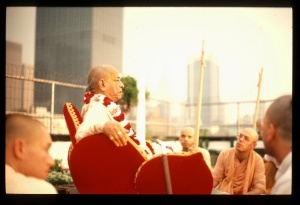CC Antya 1.188 (1975): Difference between revisions
(Vanibot #0027: CCMirror - Mirror CC's 1996 edition to form a basis for 1975) |
(Vanibot #0020: VersionCompareLinker - added a link to the Version Compare feature) |
||
| Line 2: | Line 2: | ||
<div style="float:left">'''[[Sri Caitanya-caritamrta (1975)|Śrī Caitanya-caritāmṛta (1975)]] - [[CC Antya (1975)|Antya-līlā]] - [[CC Antya 1 (1975)|Chapter 1: Śrīla Rūpa Gosvāmī's Second Meeting With the Lord]]'''</div> | <div style="float:left">'''[[Sri Caitanya-caritamrta (1975)|Śrī Caitanya-caritāmṛta (1975)]] - [[CC Antya (1975)|Antya-līlā]] - [[CC Antya 1 (1975)|Chapter 1: Śrīla Rūpa Gosvāmī's Second Meeting With the Lord]]'''</div> | ||
<div style="float:right">[[File:Go-previous.png|link=CC Antya 1.187 (1975)|Antya-līlā 1.187]] '''[[CC Antya 1.187 (1975)|Antya-līlā 1.187]] - [[CC Antya 1.189 (1975)|Antya-līlā 1.189]]''' [[File:Go-next.png|link=CC Antya 1.189 (1975)|Antya-līlā 1.189]]</div> | <div style="float:right">[[File:Go-previous.png|link=CC Antya 1.187 (1975)|Antya-līlā 1.187]] '''[[CC Antya 1.187 (1975)|Antya-līlā 1.187]] - [[CC Antya 1.189 (1975)|Antya-līlā 1.189]]''' [[File:Go-next.png|link=CC Antya 1.189 (1975)|Antya-līlā 1.189]]</div> | ||
{{CompareVersions|CC|Antya 1.188|CC 1975|CC 1996}} | |||
{{RandomImage}} | {{RandomImage}} | ||
==== TEXT 188 ==== | ==== TEXT 188 ==== | ||
| Line 12: | Line 11: | ||
:harim uddiśate rajo-bharaḥ | :harim uddiśate rajo-bharaḥ | ||
:purataḥ saṅgamayaty amuṁ tamaḥ | :purataḥ saṅgamayaty amuṁ tamaḥ | ||
: | :vrajavāma-dṛśāṁ na paddhatiḥ | ||
:prakaṭā sarva-dṛśaḥ śruter api | :prakaṭā sarva-dṛśaḥ śruter api | ||
</div> | </div> | ||
| Line 20: | Line 19: | ||
<div class="synonyms"> | <div class="synonyms"> | ||
harim—Kṛṣṇa; uddiśate—it indicates; rajaḥ-bharaḥ—dust from the cows; purataḥ—in front; saṅgamayati—causes to meet; amum—Kṛṣṇa; tamaḥ—the darkness; | harim—Kṛṣṇa; uddiśate—it indicates; rajaḥ-bharaḥ—dust from the cows,; purataḥ—in front; saṅgamayati—causes to meet; amum—Kṛṣṇa; tamaḥ—the darkness; vrajavāma-dṛśām—of the damsels of Vṛndāvana; na—not; paddhatiḥ—the course of activities; prakaṭā—manifested; sarva-dṛśaḥ—who know everything; śruteḥ—of the Vedas; api—as well as. | ||
</div> | </div> | ||
| Line 27: | Line 26: | ||
<div class="translation"> | <div class="translation"> | ||
The dust from cows and calves on the road creates a kind of darkness indicating that Kṛṣṇa is returning home from the pasture. Also, the darkness of evening provokes the gopīs to meet Kṛṣṇa. Thus the pastimes of Kṛṣṇa and the gopīs are covered by a kind of transcendental darkness and are therefore impossible for ordinary scholars of the Vedas to see.' | |||
</div> | </div> | ||
| Line 36: | Line 35: | ||
This verse from the Lalita-mādhava (1.23) is spoken by Paurṇamāsī in a conversation with Gārgī. | This verse from the Lalita-mādhava (1.23) is spoken by Paurṇamāsī in a conversation with Gārgī. | ||
Kṛṣṇa stated in the Bhagavad-gītā, traiguṇya-viṣayā vedā nistraiguṇyo bhavārjuna. Thus He advised Arjuna to rise above the modes of material nature, for the entire Vedic system is filled with descriptions involving sattva-guṇa, rajo-guṇa and tamo-guṇa. People are generally covered by the quality of rajo-guṇa and are therefore unable to understand the pastimes of Kṛṣṇa with the gopīs of Vraja. Moreover, the quality of tamo-guṇa further disturbs their understanding. In Vṛndāvana, however, although Kṛṣṇa is covered by the hazy darkness of the dust, the gopīs can nevertheless understand that within the dust storm is Kṛṣṇa. Because they are His topmost devotees, they can perceive His hand in everything. Thus even in the dark or in a hazy storm of dust, devotees can understand what Kṛṣṇa is doing. The purport of this verse is that Kṛṣṇa is never lost, under any circumstances, to the vision of exalted devotees like the gopīs. | |||
Kṛṣṇa | |||
</div> | </div> | ||
Latest revision as of 20:17, 26 January 2020

A.C. Bhaktivedanta Swami Prabhupada
TEXT 188
- harim uddiśate rajo-bharaḥ
- purataḥ saṅgamayaty amuṁ tamaḥ
- vrajavāma-dṛśāṁ na paddhatiḥ
- prakaṭā sarva-dṛśaḥ śruter api
SYNONYMS
harim—Kṛṣṇa; uddiśate—it indicates; rajaḥ-bharaḥ—dust from the cows,; purataḥ—in front; saṅgamayati—causes to meet; amum—Kṛṣṇa; tamaḥ—the darkness; vrajavāma-dṛśām—of the damsels of Vṛndāvana; na—not; paddhatiḥ—the course of activities; prakaṭā—manifested; sarva-dṛśaḥ—who know everything; śruteḥ—of the Vedas; api—as well as.
TRANSLATION
The dust from cows and calves on the road creates a kind of darkness indicating that Kṛṣṇa is returning home from the pasture. Also, the darkness of evening provokes the gopīs to meet Kṛṣṇa. Thus the pastimes of Kṛṣṇa and the gopīs are covered by a kind of transcendental darkness and are therefore impossible for ordinary scholars of the Vedas to see.'
PURPORT
This verse from the Lalita-mādhava (1.23) is spoken by Paurṇamāsī in a conversation with Gārgī.
Kṛṣṇa stated in the Bhagavad-gītā, traiguṇya-viṣayā vedā nistraiguṇyo bhavārjuna. Thus He advised Arjuna to rise above the modes of material nature, for the entire Vedic system is filled with descriptions involving sattva-guṇa, rajo-guṇa and tamo-guṇa. People are generally covered by the quality of rajo-guṇa and are therefore unable to understand the pastimes of Kṛṣṇa with the gopīs of Vraja. Moreover, the quality of tamo-guṇa further disturbs their understanding. In Vṛndāvana, however, although Kṛṣṇa is covered by the hazy darkness of the dust, the gopīs can nevertheless understand that within the dust storm is Kṛṣṇa. Because they are His topmost devotees, they can perceive His hand in everything. Thus even in the dark or in a hazy storm of dust, devotees can understand what Kṛṣṇa is doing. The purport of this verse is that Kṛṣṇa is never lost, under any circumstances, to the vision of exalted devotees like the gopīs.